The Woman Who Gave Birth To Frankenstein: A Brief Mary Shelley Biography
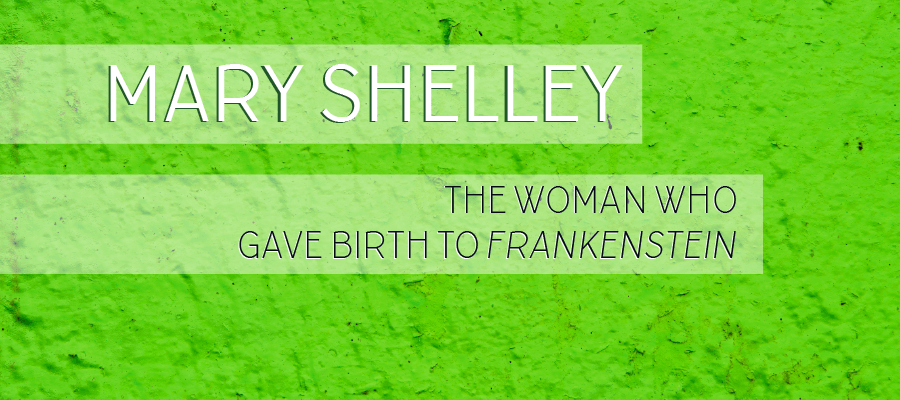
It isn’t only the music industry that has “one-hit wonders.” Believe it or not, some of the most respected authors in the Western Canon only have one chef-d’œuvre to their name. Just a few novelists who have cemented their literary reputation with just one book include:
- Harper Lee, To Kill a Mockingbird
- John Kennedy Toole, A Confederacy of Dunces
- Emily Brontë, Wuthering Heights
- Marcel Proust, In Search of Lost Time
In today’s post, we’ll be taking a look at the author Mary Shelley and her enduring one-hit wonder: Frankenstein.
Shelley may not have as much critical caché as some of the other authors mentioned above, but who could deny Shelly’s enormous impact on pop culture?
Even people who haven’t read Frankenstein vaguely know what it’s about. And whenever Halloween rolls around, you’re sure to see green “Frankenstein” costumes on store shelves. Plus, Mary Shelly’s Frankenstein has influenced countless horror films, sci-fi flicks, and even comedic spin-offs, like Mel Brooks’ Young Frankenstein.
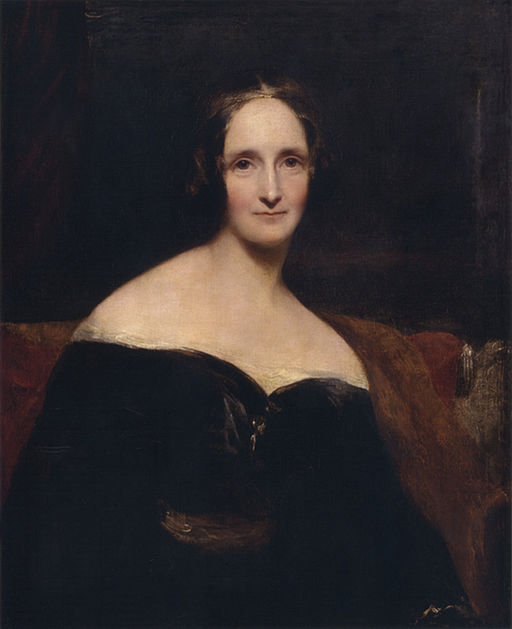
Richard Rothwell [Public domain], via Wikimedia Commons
If you want to understand the real story behind Frankenstein‘s author, read on for a brief tour of the Mary Shelley biography.
Mary Shelley’s parents
Mary Shelley was born in London on August 30th, 1797. Both of her parents were well-known radical intellectual figures in the late 18th and early 19th centuries.
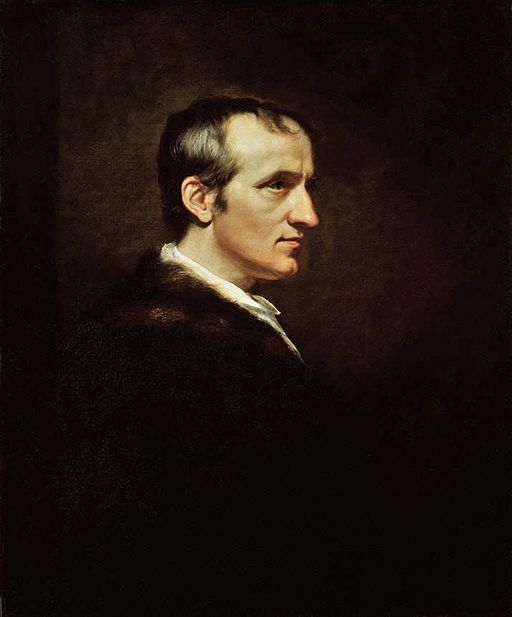
By James Northcote (1746-1831) [Public domain], via Wikimedia Commons
Her father, William Godwin, was a strong critic of aristocratic privilege and a supporter of both utilitarianism and anarchism. His most famous works include the tract An Enquiry Concerning Political Justice and the novel Things as They Are; or, The Adventures of Caleb Williams. Godwin also wrote a curious novel called St. Leon: A Tale of the Sixteenth Century that follows a French aristocrat who discovers the secret to the immortality of life. Although little read today, many critics believe the ideas found within St. Leon influenced Shelley’s creation of Frankenstein.
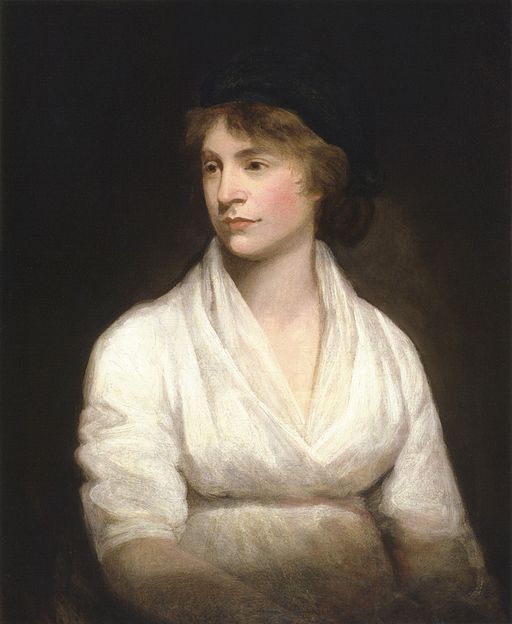
John Opie [Public domain], via Wikimedia Commons
If you’ve taken any course in English history or literature, you’ve probably come across Mary Shelly’s mother, Mary Wollstonecraft. Wollstonecraft was the prototypical feminist before the word “feminism” was even invented. Although she wrote many works on history, politics, and travel, Wollstonecraft will always be remembered for her tract A Vindication of the Rights of Woman. In this classic feminist text, Wollstonecraft argued that men and women are equal in every way and that they should be given equal opportunity in education.
Unfortunately, Mary Shelley entered the world on a sombre note. Although the birth seemed to go well at the time, Wollstonecraft became extremely ill a few days later. After suffering greatly for a few days, Wollstonecraft passed away on the 10th of September, 1797. She was 38.
Concerning his wife’s death, William Godwin wrote to a friend:
“I have not the least expectation that I can now ever know happiness again.”
Mary Shelley’s upbringing
Mary Shelley grew up with one older half-sister named Fanny Imlay, who was the product of an affair between Wollstonecraft and a mysterious soldier. Then, within a few years, Godwin married re-married to a woman named Mary Jane Clairmont. Clairmont already had two children, and soon Godwin and Clairmont had a baby boy together.
While growing up, Mary Shelley was surrounded by some of the finest artistic and intellectual minds in the UK. Just a few luminaries Godwin was on good terms with include:
- Romantic poets William Wordsworth and Samuel Taylor Coleridge
- Literary critic William Hazlitt
- Essayist Charles Lamb
Whenever she had an opportunity to be alone, Mary Shelly could often be found reading in her father’s library, outside, or even by her mother’s grave. Shelly used fiction as a means of escape from her incredibly busy home life.
The first known work published by Mary Shelly was a short poem called “Mounseer Nongtongpaw” in the year 1807. Based on a song by Charles Dibdin, this humorous verse deals with an Englishman, John Bull, who visits France without understanding a word of French. Shelley was only ten when her father published this work for her.
Mary Shelley’s husband
At this point in Mary Shelley’s biography, you’re probably wondering why her last name is “Shelley.” Well, Mary was actually born Mary Wollstonecraft Godwin, but that soon changed after she fell head over heels in love with one of England’s foremost Romantic poets: Percy Bysshe Shelley.
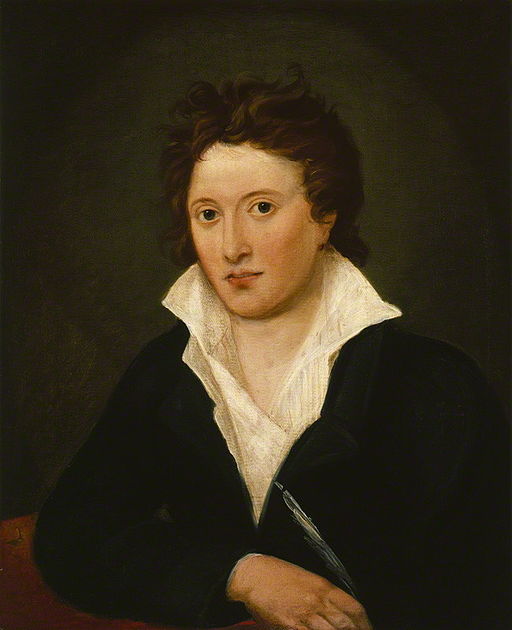
After Amelia Curran [Public domain], via Wikimedia Commons
Along with Lord Byron, Percy Shelley was one of the most radical Romantic poets of his era. Percy Shelley was an admirer of Godwin’s political theories, and he became a frequent guest at Godwin’s London home. However, after meeting Mary for the first time, Percy Shelley quickly became less interested in Godwin’s theories and more interested in his daughter.
Percy Shelley was married to Harriet Westbrook at the time, but that didn’t deter him from courting Mary. He and Mary decided to flee England together in 1815. Both Shelleys voyaged all around Continental Europe, but all was not fun and games in these early years. The couple’s first child died a few after Mary gave birth, and they were both extremely poor. This action also caused a major rift between Mary and her father.
Why did Mary Shelley write Frankenstein?
Eventually the Shelleys arrived in Geneva, Switzerland, and met up with Lord Byron, the writer John Polidori, and many other literary luminaries. The group of writers instantly formed a small bohemian community right by Lake Geneva. It was here, on an extremely stormy night, that Lord Byron suggested everyone try to write their own horror story.
After suffering from writer’s block for a few days, Mary Shelley had a strange dream of doctor creating a monster in his own image. She decided to develop this dream into a novel. Within only a few weeks, Mary Shelley produced her first draft of Frankenstein; or, The Modern Prometheus. She was only eighteen.
In case you didn’t know, Frankenstein tells the story of Dr. Victor Frankenstein and his dream to become like God by creating life in his laboratory. Using his knowledge of science, medicine, and technology, Dr. Frankenstein is able to animate assembled body parts taken from a graveyard. However, Dr. Frankenstein quickly becomes horrified and abandons his ghastly creation, hoping to put it out of his mind forever; but it isn’t long before the creature catches up with Dr. Frankenstein and vows vengeance for giving him life without any hope for true companionship.
Just a few key influences on this work include Rousseau, John Milton, and Coleridge.
This novel continues to resonate with readers today because of the deep questions it raises about unchecked scientific “progress.” Besides just being a cautionary tale against scientific exploration, some critics see Shelley’s work as an argument for the humanities.
Family suicides, marriage, and the move to Italy
Although 1816 was a year of creative breakthrough for Mary Shelley, it was also a year of tragedy. Both Shelley’s half-sister and Percy Shelley’s first wife committed suicide. Despite this news, Mary and Percy Shelley decided to get officially married in December of this year.
Shelley continued work on Frankenstein throughout the next few years, and she published the first edition of the work anonymously in 1818. Although Mary Shelley had released a travelogue in 1817 called History of a Six Weeks’ Tour, most people assumed only Percy Bysshe Shelley could have written a work like Frankenstein—especially because he wrote the initial introduction to the novel.
Regardless of this speculation, the book sold tremendously in the U.K. and allowed the Shelleys to buy a home in Italy.
Percy Shelley’s death
Soon after arriving in Italy, Mary Shelley faced great difficulties. Two more of her children died in their infancy, and Percy Shelley would often cheat on Mary. It wasn’t until 1819 that Mary Shelley gave birth to a son, Percy Florence Shelley, who actually survived childbirth.
Then, in 1822, Percy Shelley unexpectedly drowned in the Gulf of Spezia. Most historians believe this was just a freak sailing accident, but other critics believe Percy Shelley could have intentionally taken his own life. Either way, Percy Shelley’s early death at the age of 29 was a great loss to the literary world.
Perhaps Shelley’s most known work today is the sonnet “Ozymandias,” from which the famed quote comes:
“Look on my Works, ye Mighty, and despair!”
Mary Shelley’s later life
After Percy Shelley’s death, Mary Shelley decided to move back to England to better care for Percy Florence. Percy Florence went on to study at Trinity College, Cambridge, and, once Godwin passed away in 1844, took up his role as the 3rd Baronet of Castle Goring. Until this time, Mary Shelley provided for her son by writing more novels, including Valperga and The Last Man.
Of the Mary Shelley books, one entitled Mathilda was only discovered long after her death. It might not be so popular with modern readers, but Mathilda, which deals with the scandalous issue of a father falling in love with his 16-year old daughter, has been puzzling scholars ever since it was discovered in the 1950s.
In addition to writing these novels and other works, Mary Shelley spent a great deal of time promoting her late husband’s work. Indeed, thanks in large part to Mary Shelley’s efforts, we still have much of Percy Bysshe Shelley’s poetry in print.
Mary Shelley passed away due to brain cancer on the 1st of February, 1851. Mary was cremated along with her husband’s preserved heart at St. Peter’s Church in Bournemouth. She was 53.
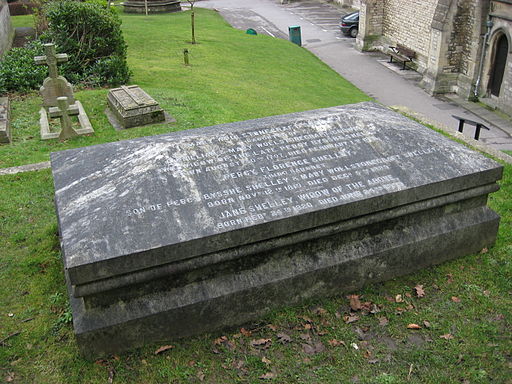
LordHarris at en.wikipedia GFDL (http://www.gnu.org/copyleft/fdl.html) or CC BY 3.0, via Wikimedia Commons
Although Percy Florence married a woman named Jane Gibson, they had no offspring together. That makes Percy Florence the last in the mythical lineage of Godwin, Wollstonecraft, and the Shelleys. Unlike his parents, Percy Florence had a very long life, dying in 1889 at the age of 70.
Mary Shelley’s impact
Mary Shelley gave the world Dr. Frankenstein and his “Creature.” As long as we continue to celebrate Halloween, you can be sure people will be mistaking “Frankenstein” for “Frankenstein’s Monster.”

Christian Michaud (Victor Frankenstein) et Étienne Pilon (La Créature) by Deckard97, via Wikimedia Commons
Beyond the spectacle we’ve created around Frankenstein’s monster, the real reason this tale terrifies us has to do with the questions it raises about our reliance on science and technology. In our age of nuclear energy, CERN, and biotechnology, perhaps there’s no better time to study this classic novel.
If you haven’t already, do yourself a favor and read Mary Shelley’s Frankenstein this weekend. You’ll be amazed at how fresh this book’s structure and content are for the modern mind.
Full-text Frankenstein book poster
Love Mary Shelley’s Frankenstein? Check out our full-text Frankenstein book poster for a haunting image of Dr. Frankenstein’s tragic and ill-fated creature.






Leave a Reply
1 Comment on "The Woman Who Gave Birth To Frankenstein: A Brief Mary Shelley Biography"
prof prem raj pushpakaran writes — 2018 marks the bicentennary year of mary shelley’s work, “Frankenstein” !!!!